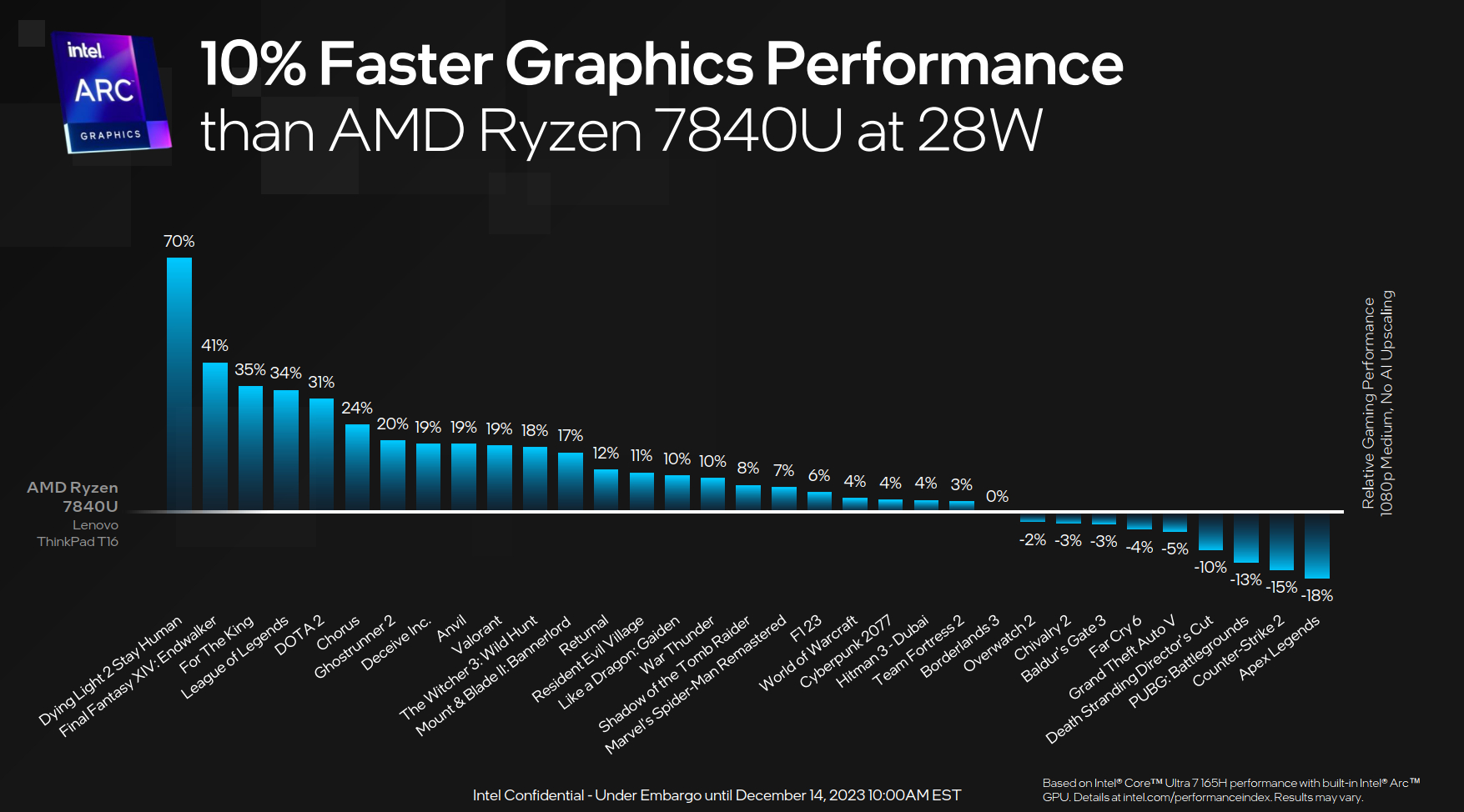Intel shows integrated Arc GPU for Meteor Lake is 10% faster than AMD Radeon 780M, across 33 games tested
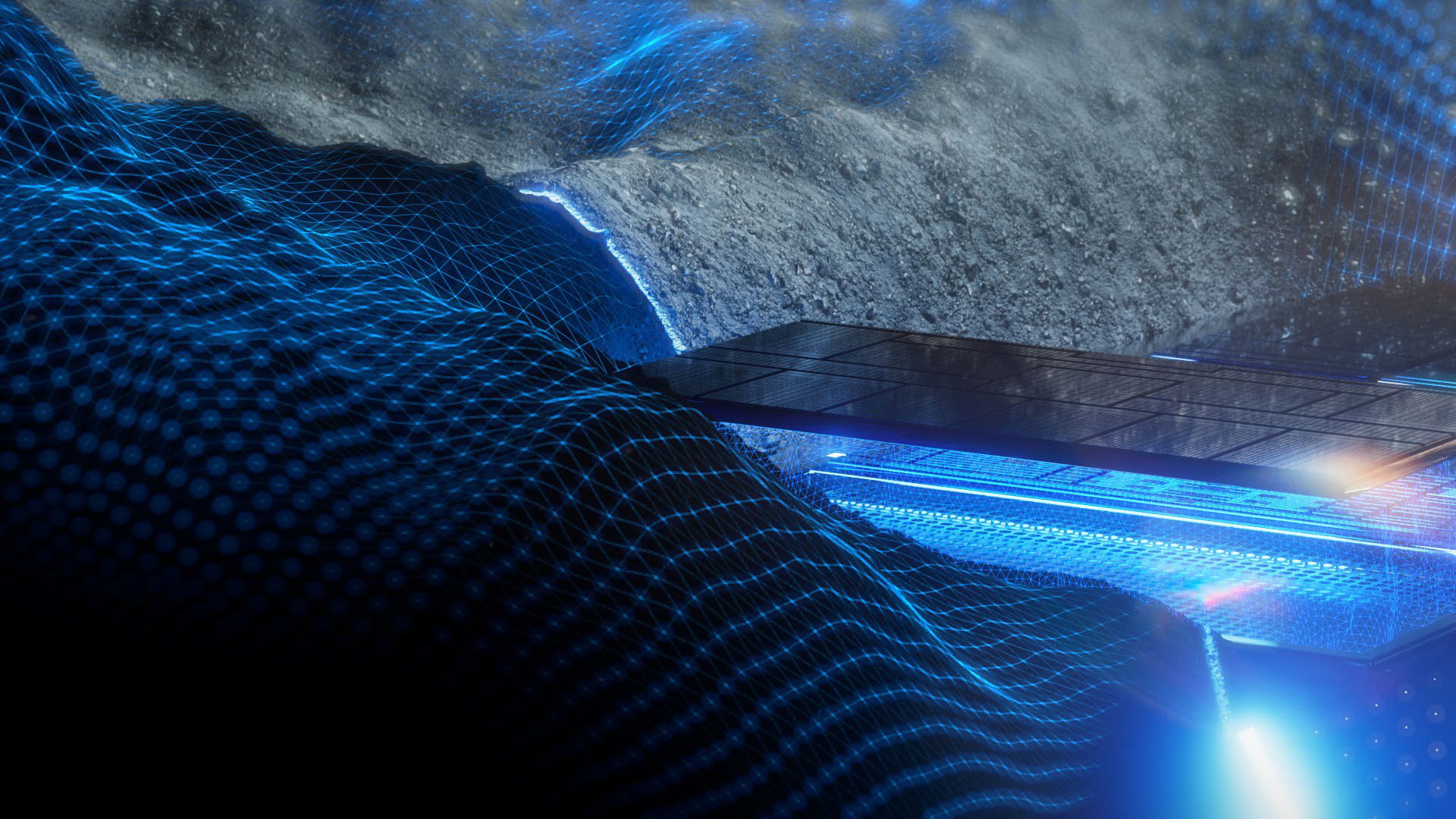
Intel launched its Meteor Lake CPUs for laptops today, and along with the various models, it provided some in-house benchmarks of both the CPU and GPU. We're still waiting for our first laptop reviews using the new chips, but this marks a pretty substantial step forward for what we can expect from Intel integrated graphics, as it will have Arc-branded GPUs on the top H-series parts.
Intel provided many details about the Meteor Lake graphics tile architecture back in September, but at the time it didn't provide any concrete examples of what we can expect in terms of real-world gaming performance other than a nebulous claim of "double" the performance. With today's launch, that changes, and while independent benchmarks will have to wait a bit longer, we can at least start with the Intel number — sprinkled with salt, as usual for any manufacturer-provided tests.
Previously, Intel made claims about potentially doubling the integrated graphics performance. Now, even by its own data, tested at 1080p and medium settings across a suite of 16 games, that appears to be more of an "at most" figure rather than something we're likely to see in a lot of games.
The test suite consists of a collection of relatively demanding as well as lighter games. Apex Legends, GTAV, DOTA2, Team Fortress 2, League of Legends, Counter-Strike 2, and World of Warcraft all trend toward the lighter side of the spectrum, particularly when using "medium" settings. But Borderlands 3, Resident Evil Village, Far Cry 6, and PUBG are all at least reasonably taxing.
Of course, Intel didn't provide actual FPS values for these benchmarks, instead showing percent improvement of a Core Ultra 7 165H compared to the previous generation Core i7-1370P, so it's a bit difficult to say precisely how well the Arc GPU was able to run the various games — is it doubling performance from 20 to 40 FPS, or doubling from 40 to 80 FPS? That would depend on the game and other factors, but we don't have the raw numbers.
Update: Intel also provided the above benchmark chart, comparing its Meteor Lake integrated Arc GPU in a Core Ultra 7 165H with AMD's Radeon 780M running in a Ryzen 7 7840U laptop. These are both 16-inch class laptops, running 28W TDP processors, so it's at least reasonably like-for-like comparisons.
Intel ran 33 gaming benchmarks on the two laptops, and showed an average performance advantage of 10% with the integrated Arc GPU. It's not a universal win for Intel, which is realistic — we'd be far more suspicious if every test showed Arc in the lead.
AMD garnered modest 10–18 percent wins in Death Stranding, PUBG, Counter-Strike 2, and Apex Legends. Meanwhile, Intel Arc came out with larger leads of 10% to as much as 70% in sixteen of the tested games — with Dying Light 2, Final Fantasy XIV, For the King, League of Legends, and Dota 2 all showing leads of 30% or more. The remaining games fall in the -5% to +8% range, which is close enough to basically categorize them all as being a tie.
Based on the broad selection of games, it looks like a reasonable statement that Intel's integrated Arc GPU will be able to compete with AMD's currently fastest integrated Radeon 780M. Neither one will be great for high-end gaming, but both should be able to do reasonably well at 1080p medium settings.
Intel also talked up its XeSS upscaling algorithm again, which runs in DP4a mode on the integrated Arc GPUs. This is in contrast to the desktop Arc graphics cards, which all have XMX (Xe Matrix eXtensions) support and uses different code. In the past, XeSS running on XMX looked clearly superior to the DP4a mode, but Intel worked on improving the DP4a quality since XeSS first launched, and it should be more comparable to FSR2 and even DLSS2 upscaling quality now.
Note also that there are two DP4a options for XeSS. One is tuned to run optimally on Intel's enhanced DP4a engines and provides better performance on Intel GPUs. The other is a general DP4a implementation that runs on non-Intel GPUs. The quality of the two DP4a code paths should be the same, so it's only the performance that would potentially differ. Considering most games that support XeSS also support either DLSS, FSR2, or both, it's not a particularly critical factor.
Anyway, looking at the performance, Intel shows an average improvement of 39% across the 15 games tested, at 1080p. It's unclear if this is using different upscaling factors or settings, depending on the game, but normally we'd only recommend using Quality (or even Ultra Quality) mode upscaling at 1080p.
Intel does provide exact figures for the improvements measured, which range from 11% in Chivalry 2 to as much as 129% in Like a Dragon Gaiden — and yes, that's very much an outlier and we wouldn't normally expect XeSS or any other upscaling algorithm to double performance with 2X Quality upscaling. Witcher 3 also shows a near doubling of performance from XeSS (93%), while most of the other games fall in the 30~40 percent improvement range.
We've gone into more detail on the various Meteor Like CPU models elsewhere, but we also wanted to quickly note the differences in the various SKUs on the GPU side of the equation. There are two Meteor Lake processor variants right now, a "large" chip used in the H-series, and a "small" chip used in the U-series parts.
Two major differences between the chips are on the Compute Tile (CPU P-cores and E-cores, cache, and other elements), and on the GPU Tile (GPU Xe-Cores and a few other related bits). The Compute Tile is manufactured using Intel's own Intel 4 process node, and comes with up to six P-cores and eight E-cores on the larger chip, or two P-cores and eight E-cores on the smaller chip.
The GPU Tile is manufactured using TSMC's N5 process node, which represents a step up from the N6 node used on the desktop Arc GPUs. There are two variants again, with up to eight Xe-cores on the larger H-series chips, and up to four Xe-cores on the smaller U-series parts. The H-series also clocks the GPU at up to 2.35 GHz, while the U-series tops out at 2.0 GHz — and power limits could mean lower clocks in normal use.
Architecturally, the two GPU variants are the same, with the only real difference being the number of Xe-cores and the boost clock. However, in order to avoid diluting the Arc brand, only Meteor Lake chips with the larger GPU Tile will use the Arc name — the others will use Intel Graphics branding.
It's also interesting to note that the GPU Tile is almost purely focused on GPU compute, as most of the other graphics-related functionality is located on other tiles (the IO Tile and SoC Tile, to be specific). Intel didn't provide details on the tile sizes, but we'd guess the larger chip will be close to twice as large as the smaller chip.
Wrapping things up, Intel also provided some like-for-like comparisons of its new Core Ultra 7 165H's graphics performance against AMD's Ryzen 7 7840U. That might seem unfair, pitting an H-series part against a U-series competitor part, though both chips have a base 28W TDP rating. That doesn't mean both chips are using the same amount of power when playing games, however, and that's something we'll need to dig into more when we get actual laptops for testing.
Going with the provided data, Intel showed up to 5% higher performance than AMD's Radeon 780M when looking at the 16-inch laptops, with the 14-inch Intel laptop matching the performance of the 16-inch AMD laptop. The example 14-inch AMD laptop meanwhile dropped 11% in performance, presumably due to thermal limits and power restrictions associated with the more compact form factor.
There are some refreshed AMD "Hawk Point" processors coming out soon, but to all appearances those are effectively renamed variants of the existing "Phoenix Point" chips. We'll need to wait for the future "Strix Point" processors before AMD makes more significant upgrades, though even then it may be more AI and NPU updates rather than substantial GPU improvements.
Laptop vendors should already have Meteor Lake based models available for order, though many more models and brands should appear in the coming months. As these are mobile-focused chips, we also know that performance and other features can vary quite a bit, based on the particulars of design. We anticipate seeing a lot of new laptops, using both AMD and Intel processors, in the coming months, and likely many will be shown off at CES in January. Once we have those in hand, we'll be able to better quantify how Intel's integrated Arc GPU stacks up to the competition.
The full slide deck (at least, the portions related to the integrated Arc GPUs) is available below for reference, including additional details about Intel's testing.


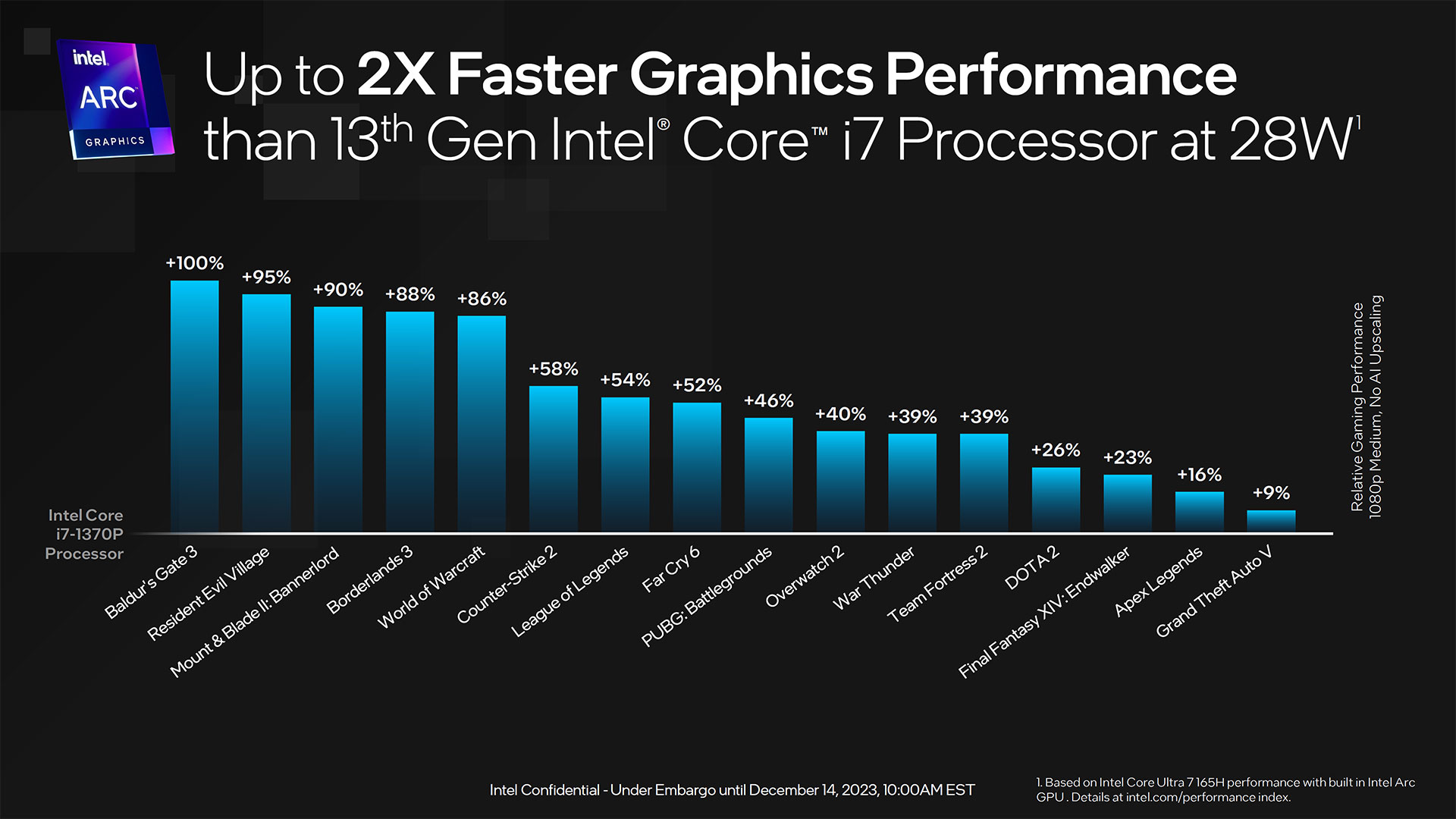
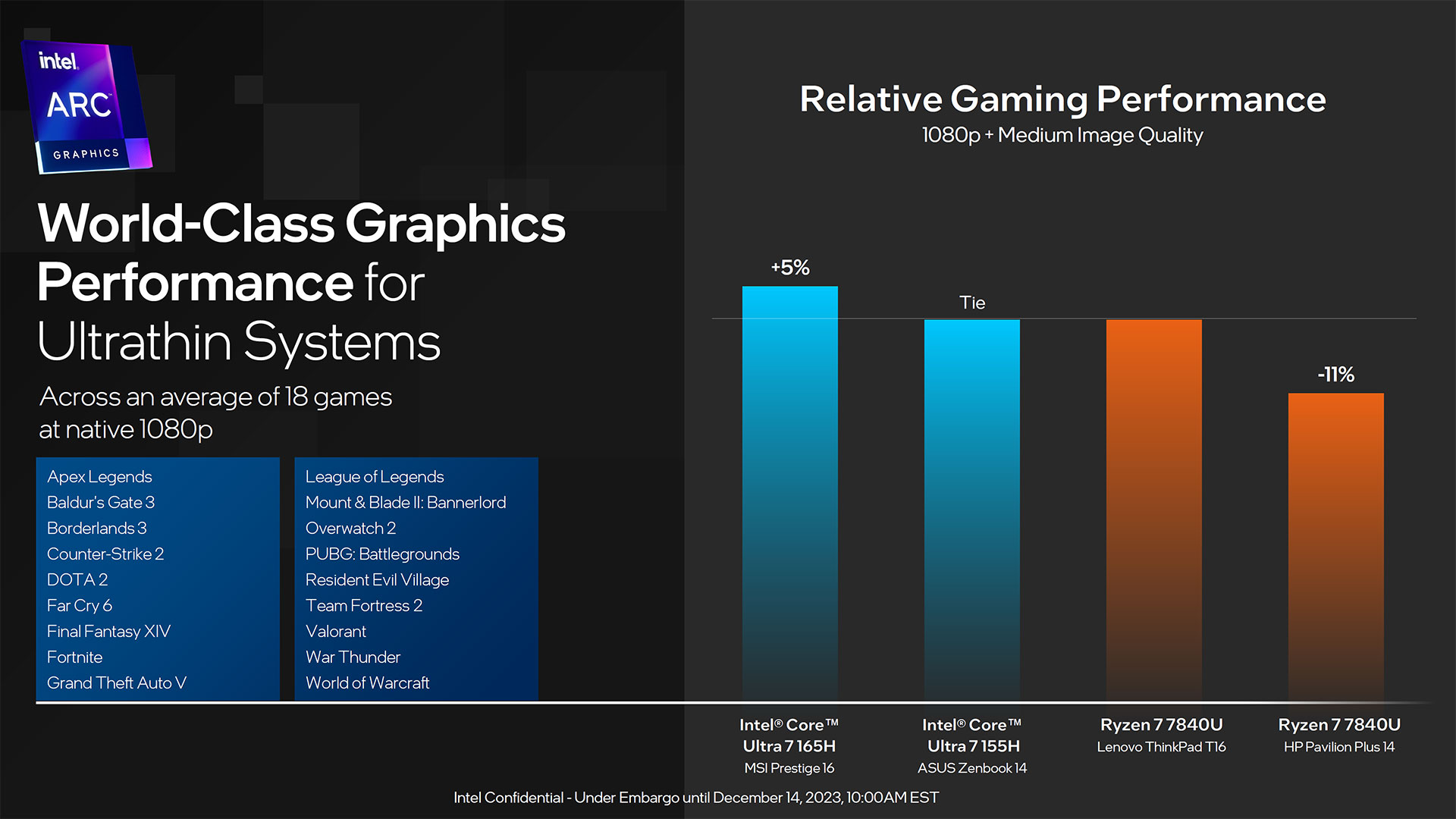
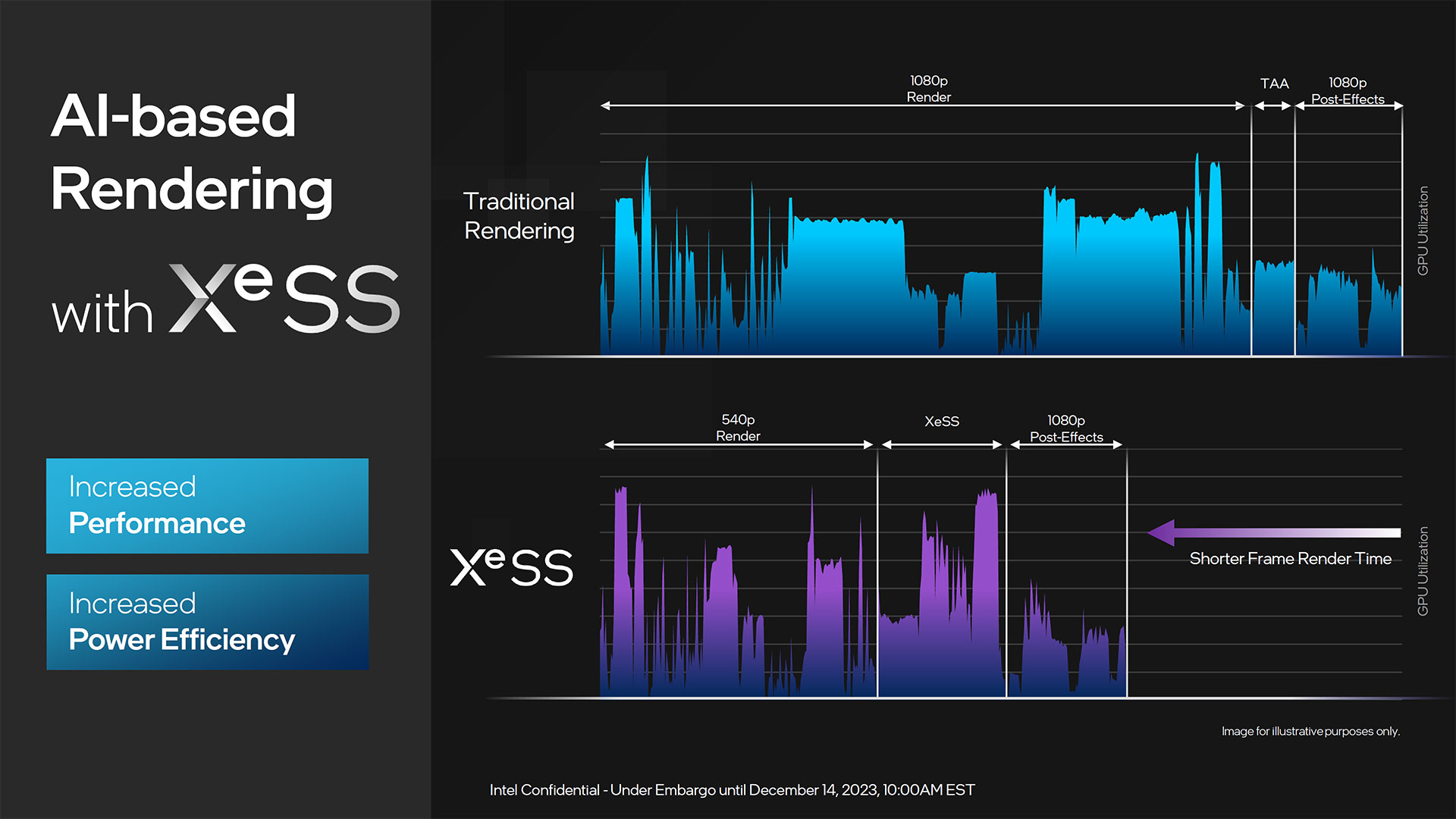
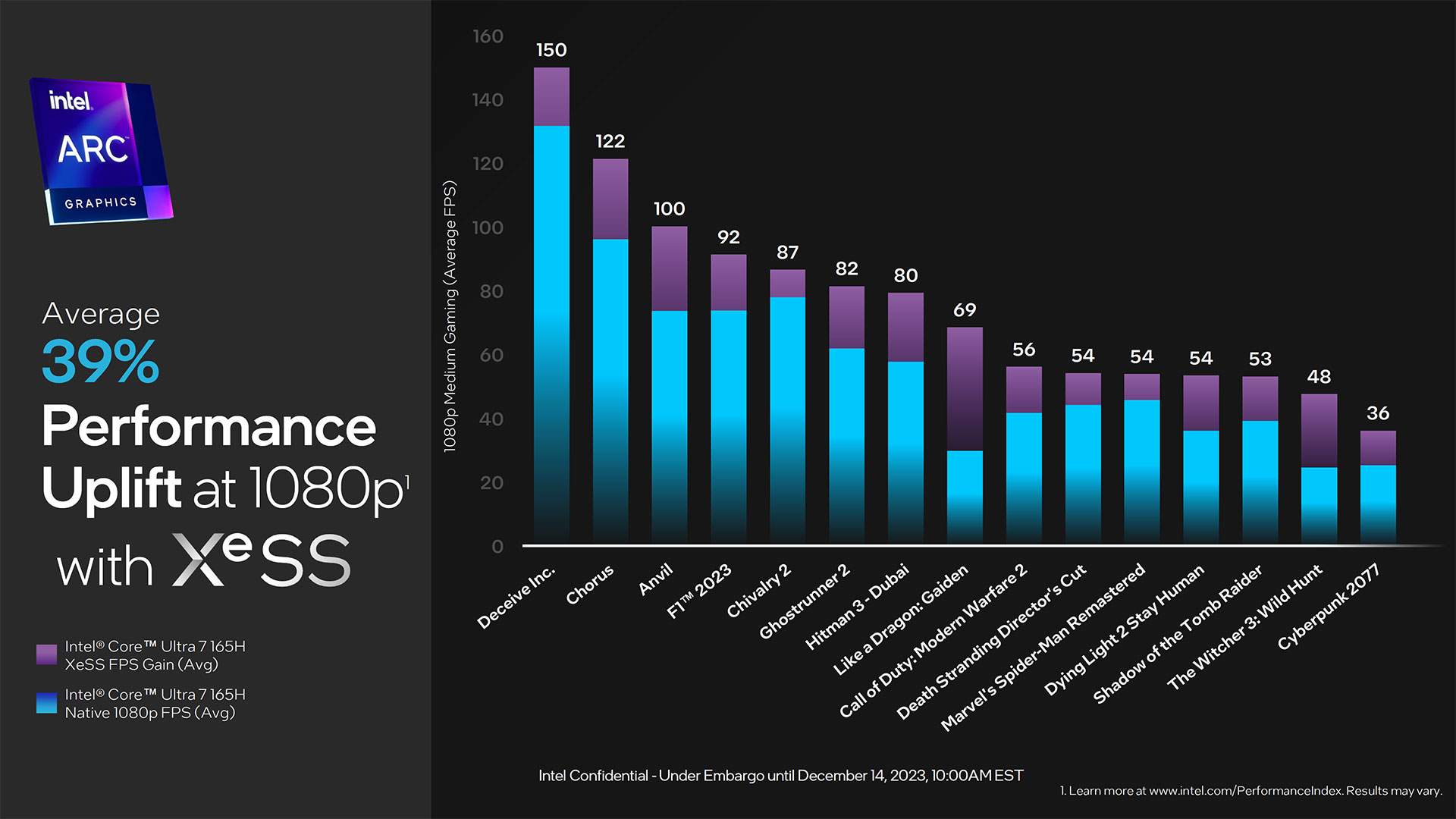


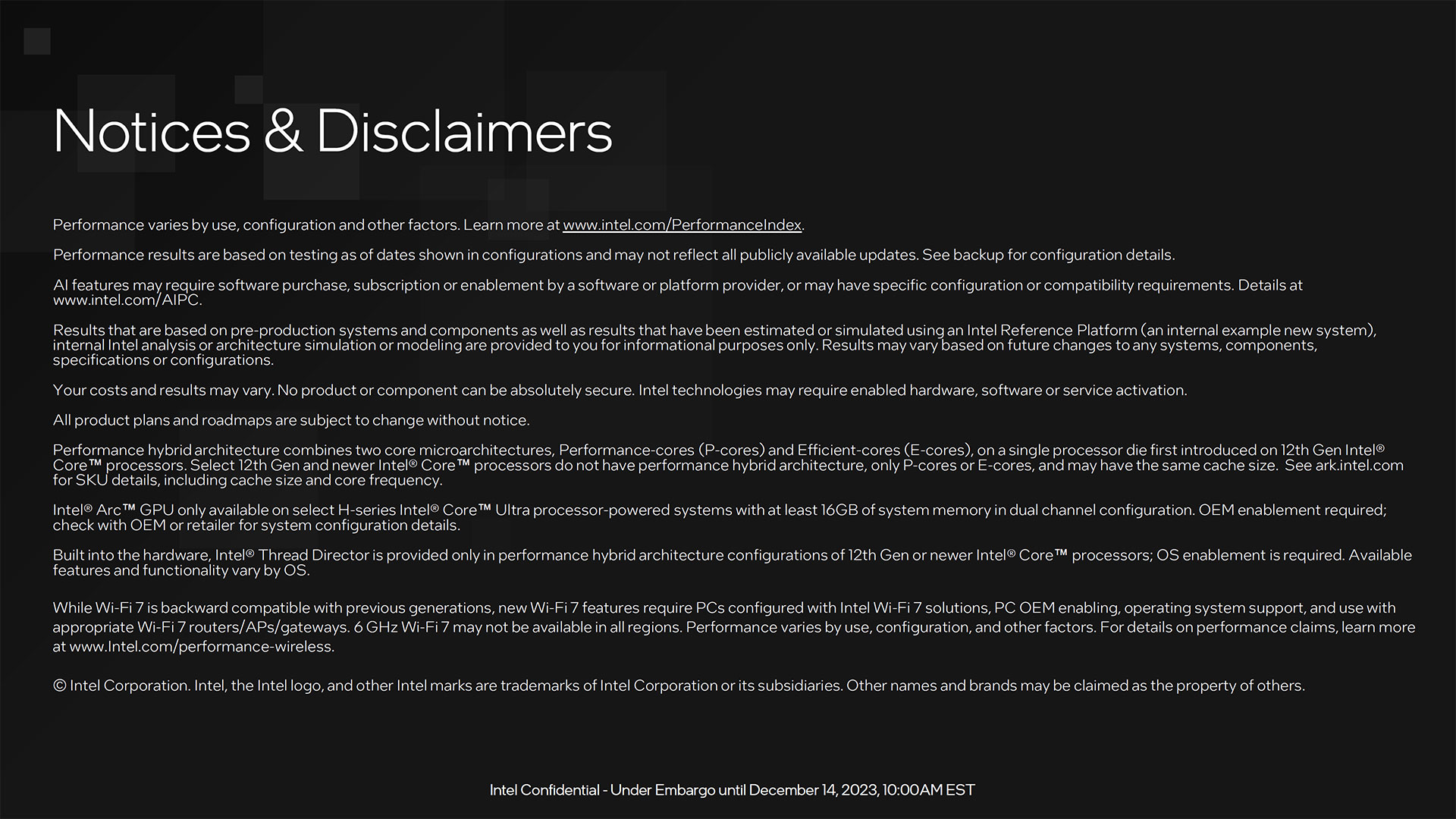
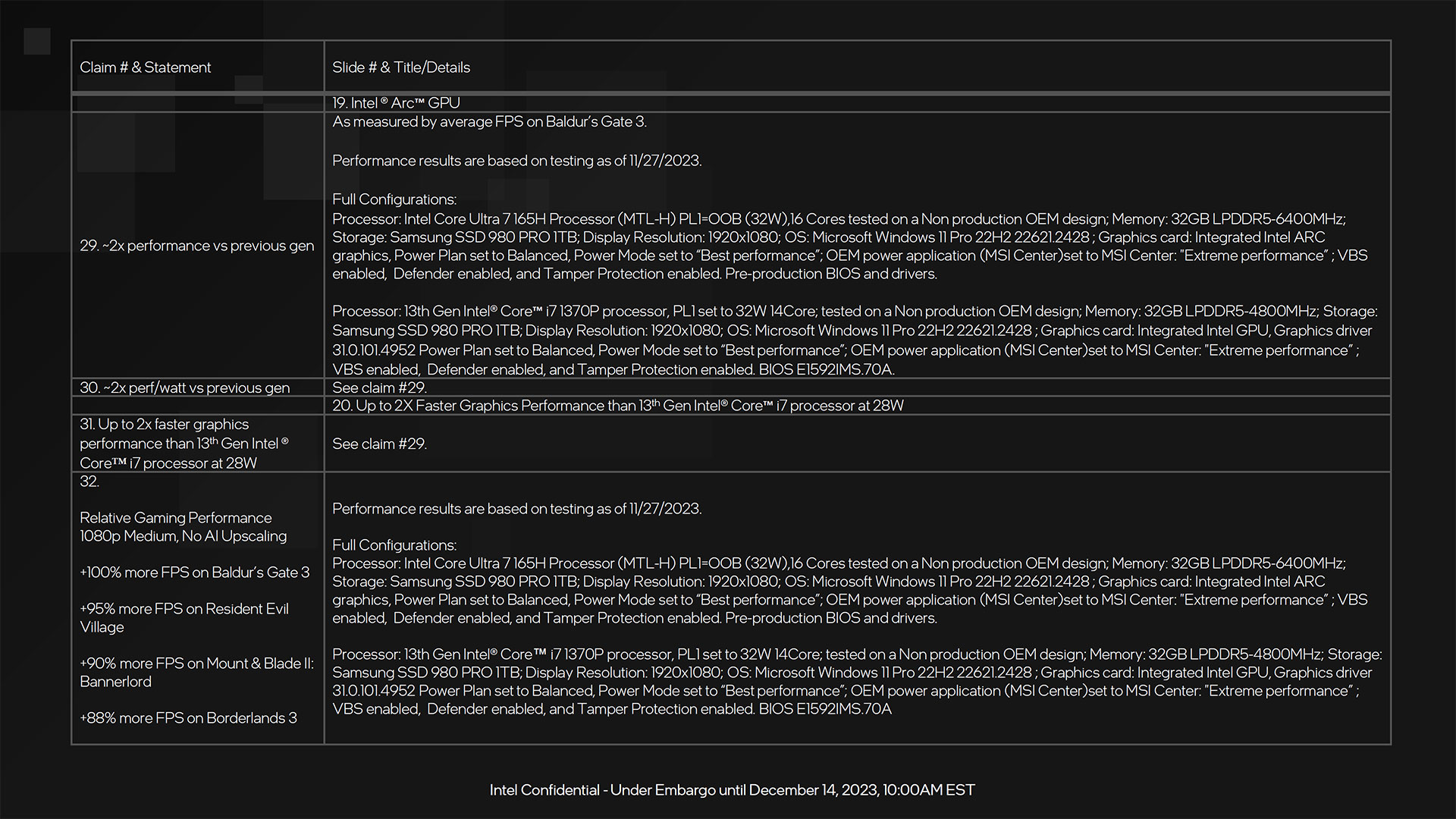
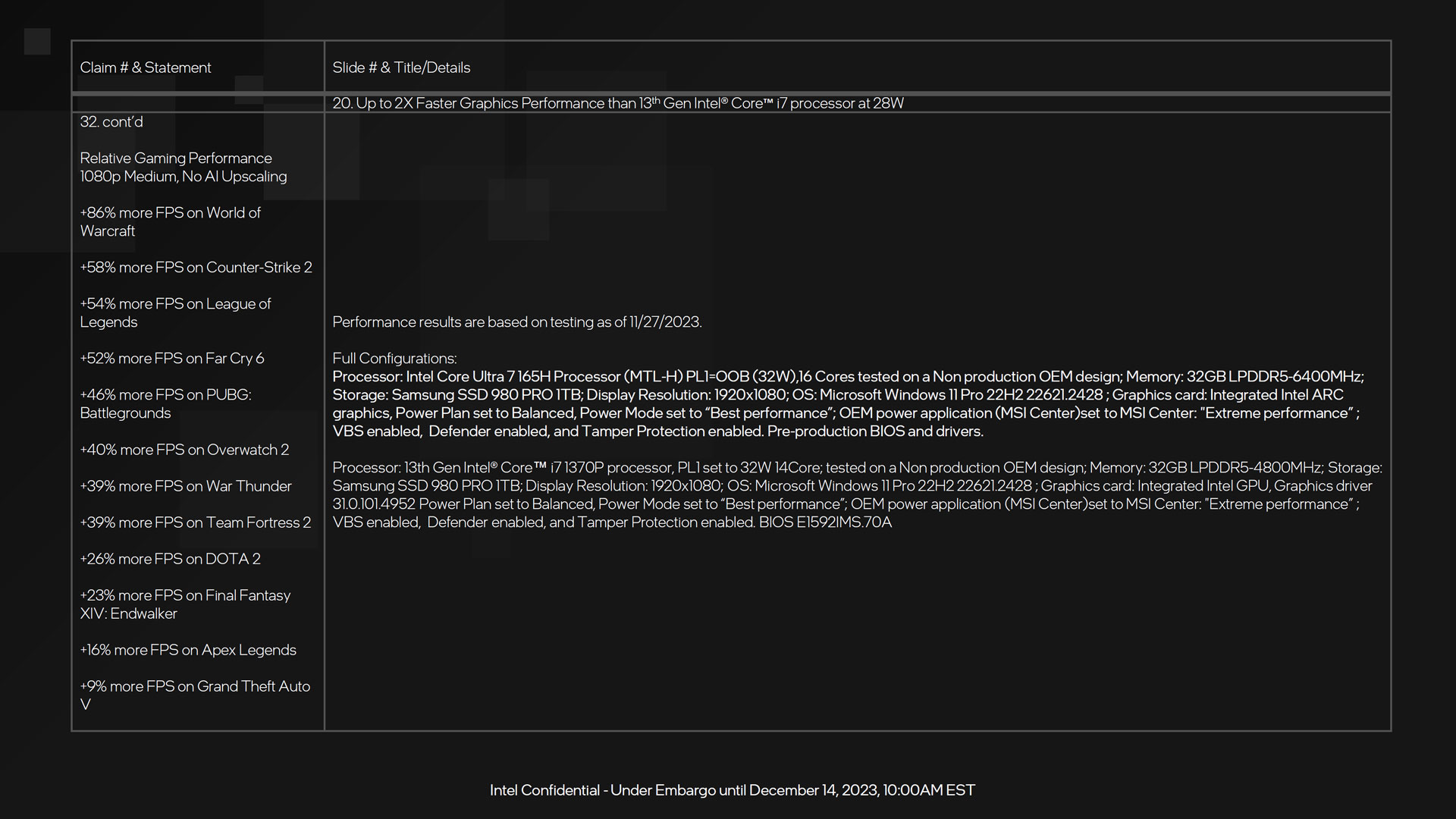

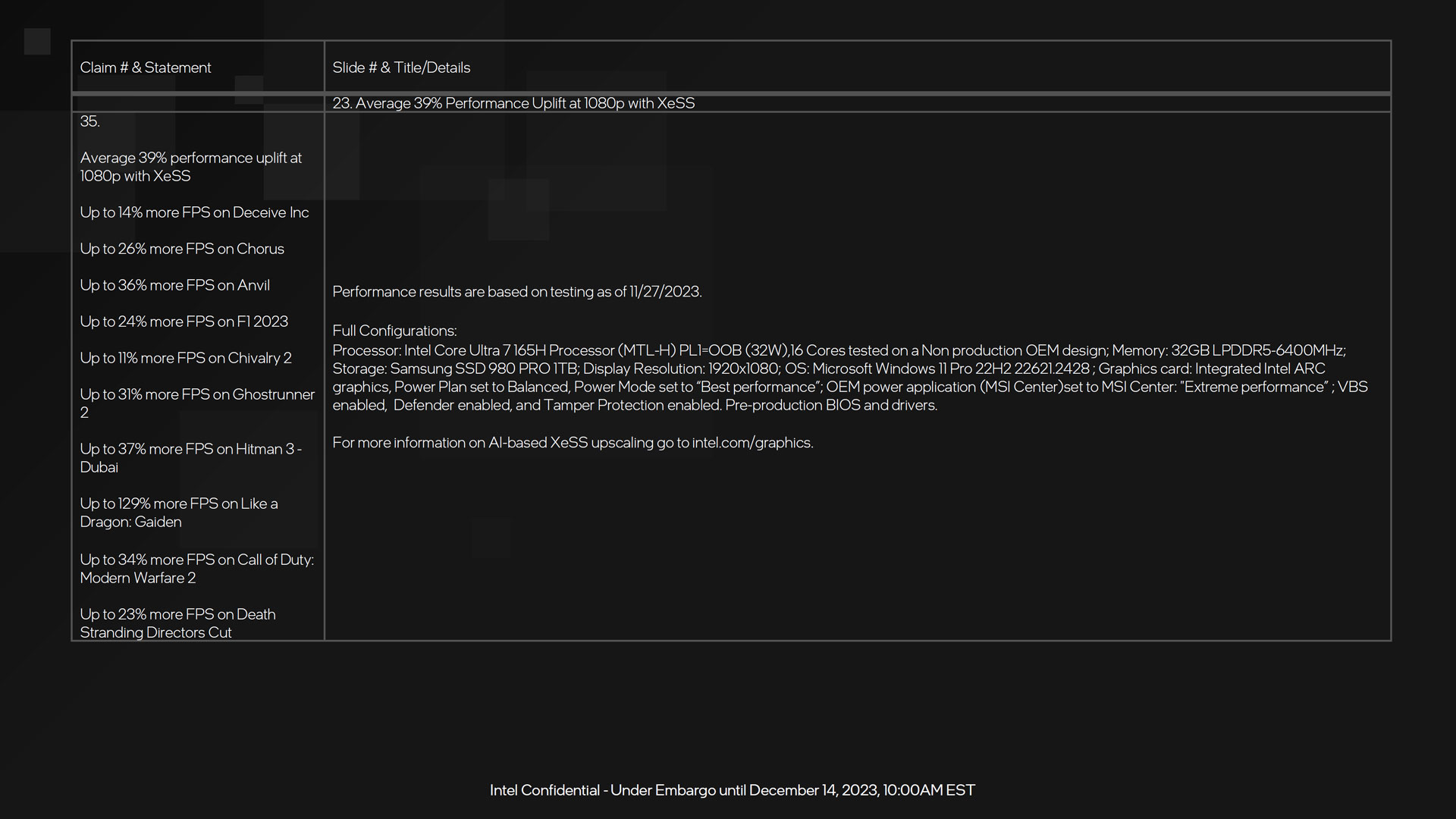
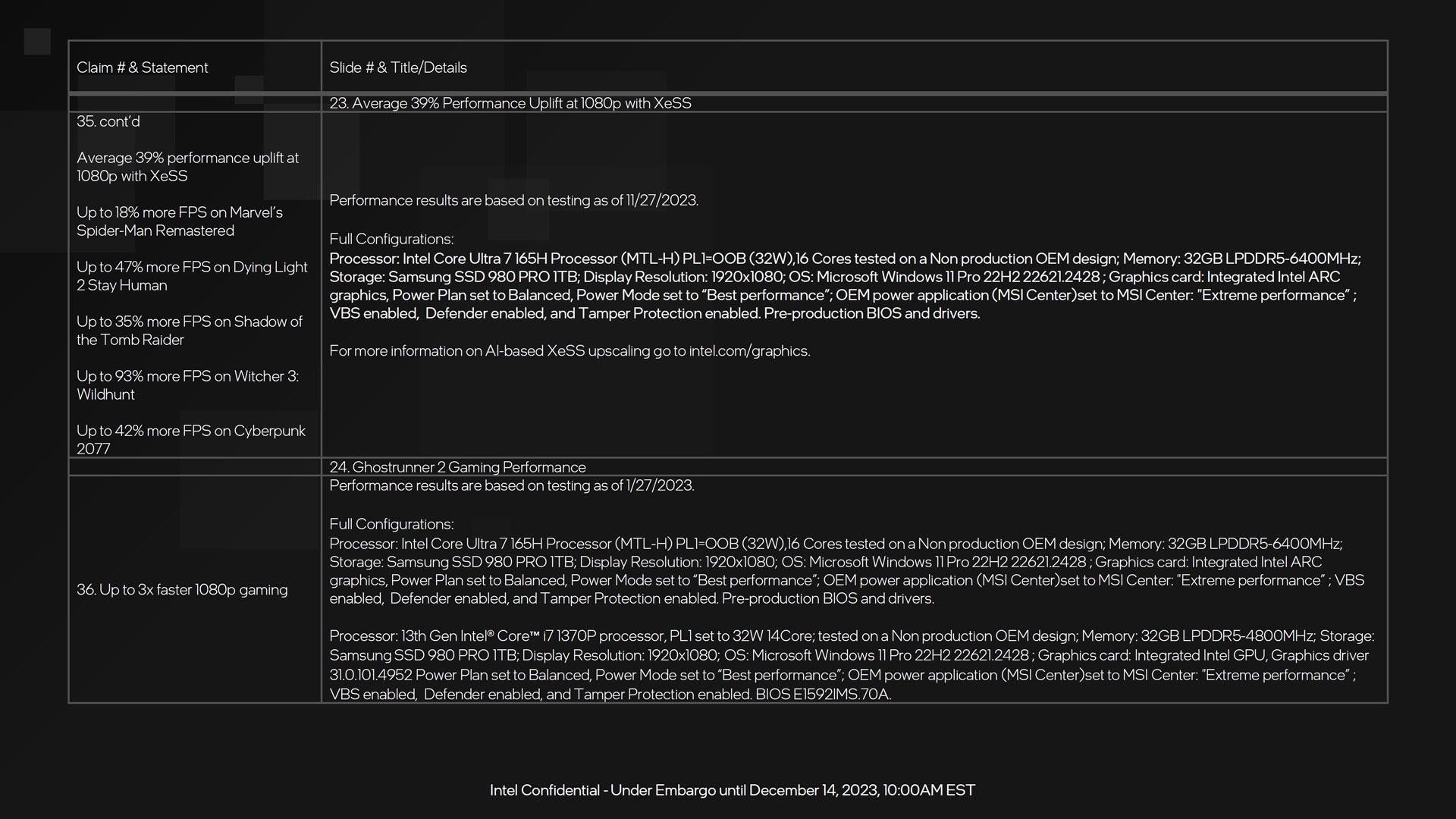

Get Tom's Hardware's best news and in-depth reviews, straight to your inbox.

Jarred Walton is a senior editor at Tom's Hardware focusing on everything GPU. He has been working as a tech journalist since 2004, writing for AnandTech, Maximum PC, and PC Gamer. From the first S3 Virge '3D decelerators' to today's GPUs, Jarred keeps up with all the latest graphics trends and is the one to ask about game performance.
-
Marlin1975 As much power as they pull at 100% I would hope so.Reply
Seems like minor gains at best and higher power usage at worse. -
thisisaname Replywe can at least start with the Intel number — sprinkled with salt, as usual for any manufacturer-provided tests.
Shame we can not trust manufacturer-provided tests.
-
JarredWaltonGPU Reply
It's not actually clear how much power the chips are using for these workloads. Base TDP is 28W, peak power draw of 115W... but I don't think these chips sustain that for more than a very short burst. But independent testing is certainly needed.Marlin1975 said:As much power as they pull at 100% I would hope so.
Seems like minor gains at best and higher power usage at worse.
I'm also disappointed there's no low power U-series part that uses the larger package. I want a Core Ultra 7 165U or whatever that has a 15W TDP but still gets the full eight Xe-core graphics. -
digitalgriffin Real PCMRs don't game on laptops. I know it's a snobbish thing to say. But it's true. Casual gamers don't need much GPU power. And serious gamers need big screens, a good keyboard and mouse, no power limits, and long run times with easy maintenance. A laptop offers none of these. Laptop are great if you want to play something like city skylines 1 or civ on the road or airplane. But nothing serious. And if I'm on the road, I'm not sitting in a hotel room playing games.Reply
GPU improvements are useful if there are productivity lifts though for things like Photoshop, premiere, and cinebench. -
Eximo As long as they can get the drivers right. I was lucky my laptop has the lowest end Nvidia card in it. Most websites have ads, ads made the Intel GPU give a blank screen until the ad was off the screen. Probably been fixed by now, but I see no reason to burden my CPU temps with website rendering.Reply -
TerryLaze Reply
Sorry, but nobody cares about MR..digitalgriffin said:Real PCMRs don't game on laptops. I know it's a snobbish thing to say. But it's true. Casual gamers don't need much GPU power. And serious gamers need big screens, a good keyboard and mouse, no power limits, and long run times with easy maintenance. A laptop offers none of these. Laptop are great if you want to play something like city skylines 1 or civ on the road or airplane. But nothing serious. And if I'm on the road, I'm not sitting in a hotel room playing games.
GPU improvements are useful if there are productivity lifts though for things like Photoshop, premiere, and cinebench.
Have you heard about a little thing called steam deck?! That's enough gaming for the vast majority of gamers, as was and still is proven by the sales.
If intel can match that then they have to do it, sooner rather than later. -
Giroro ReplyTerryLaze said:Sorry, but nobody cares about MR..
Have you heard about a little thing called steam deck?! That's enough gaming for the vast majority of gamers, as was and still is proven by the sales.
If intel can match that then they have to do it, sooner rather than later.
People selling $300 racecar chairs and $100 "streamer" LED lamps care a whole lot about MR... -
thestryker Hardware Canucks got a pre-release Asus Zenbook 14 and ran some testing though they said there were weird stability issues they couldn't nail down other than suggesting firmware issue.Reply
Obtc24lwbrwView: https://www.youtube.com/watch?v=Obtc24lwbrw
Here's a few screen grabs of some of the gaming results:
